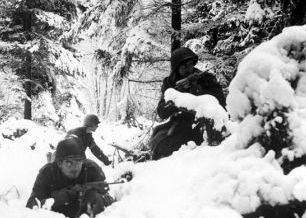The Battle of the Bulge ends - 1945
The Battle of the Bulge (also known as the Ardennes Counteroffensive, and the Von Rundstedt Offensive to the Germans) was a major German offensive launched through the densely forested Ardennes mountain region of Wallonia in Belgium, and France and Luxembourg on the Western Front towards the end of World War II. The Wehrmacht's code name for the offensive was Unternehmen Wacht am Rhein, after the German patriotic hymn Die Wacht am Rhein. The French name for the operation is Bataille des Ardennes.
The German offensive was supported by several subordinate operations known as Unternehmen Bodenplatte, Greif, and Währung.Germany's goal for these operations was to split the British and American Allied line in half, capturing Antwerp and then proceed to encircle and destroy four Allied armies, forcing the Western Allies to negotiate a peace treaty in the Axis Powers' favour. Once accomplished, Hitler could fully concentrate on the eastern theatre of war.
The offensive was planned with the utmost secrecy, minimizing radio traffic and moving troops and equipment under cover of darkness. Although Ultra suggested a possible attack and the Third U.S. Army's intelligence staff predicted a major German offensive, the Allies were still caught by surprise. This was achieved by a combination of Allied overconfidence, preoccupation with their own offensive plans, and poor aerial reconnaissance.
Near-complete surprise against a weakly defended section of the Allied line was achieved during heavy overcast weather, which grounded the Allies' overwhelmingly superior air forces. Fierce resistance, particularly around the key town of Bastogne, and terrain favouring the defenders threw the German timetable behind schedule. Allied reinforcements, including General George S. Patton's Third Army, and improving weather conditions, which permitted air attacks on German forces and supply lines, sealed the failure of the offensive.
In the wake of the defeat, many experienced German units were left severely depleted of men and equipment, as survivors retreated to the defenses of the Siegfried Line. For the Americans, with about 610,000 men committed and some 89,000 casualties, including 19,000 killed,the Battle of the Bulge was the largest and bloodiest battle fought on western front in World War II.
The German offensive was supported by several subordinate operations known as Unternehmen Bodenplatte, Greif, and Währung.Germany's goal for these operations was to split the British and American Allied line in half, capturing Antwerp and then proceed to encircle and destroy four Allied armies, forcing the Western Allies to negotiate a peace treaty in the Axis Powers' favour. Once accomplished, Hitler could fully concentrate on the eastern theatre of war.
The offensive was planned with the utmost secrecy, minimizing radio traffic and moving troops and equipment under cover of darkness. Although Ultra suggested a possible attack and the Third U.S. Army's intelligence staff predicted a major German offensive, the Allies were still caught by surprise. This was achieved by a combination of Allied overconfidence, preoccupation with their own offensive plans, and poor aerial reconnaissance.
Near-complete surprise against a weakly defended section of the Allied line was achieved during heavy overcast weather, which grounded the Allies' overwhelmingly superior air forces. Fierce resistance, particularly around the key town of Bastogne, and terrain favouring the defenders threw the German timetable behind schedule. Allied reinforcements, including General George S. Patton's Third Army, and improving weather conditions, which permitted air attacks on German forces and supply lines, sealed the failure of the offensive.



0 Response to "The Battle of the Bulge ends - 1945"
Post a Comment